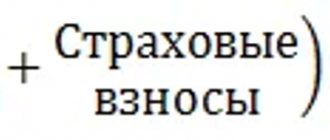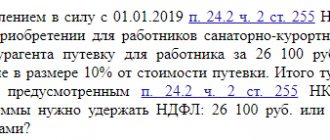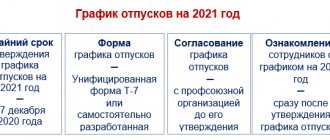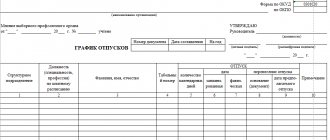Another tax period has ended. Organizations are preparing to submit their annual income tax return. Let us remind you that according to clause 4 of Art. 289 of the Tax Code of the Russian Federation, its submission to the tax office must be carried out no later than March 28.
When calculating the taxable base for the tax period, the following must be taken into account.
Taxpayers who during the year formed certain reserves provided for in Chapter. 25 of the Tax Code of the Russian Federation are required to carry out their inventory as of December 31. The purpose of such an inventory is to identify the amount of underutilization of the reserve or its overexpenditure and adjust the taxable base.
The article will discuss the reserve for upcoming expenses for vacation pay, the procedure for the formation and use of which is established by Art. 324.1 Tax Code of the Russian Federation.
Inventory of the reserve for vacation pay: sample
Before the formation of the final annual reports, an inventory of the reserve for vacation pay is carried out. The main goal of such an event is to identify amounts of overexpenditure or underuse of funds and adjust the tax base.
Inventory of the reserve for vacation pay - execution mechanism
The right of taxpayers to form vacation reserves is provided for by Stat. 324.1 NK. The accounting procedure for such transactions, including the monthly percentage and deduction limit, must be fixed in the accounting policy. According to current legislative norms, organizations are not required to use reservations, and those who work on a cash basis cannot take advantage of this benefit.
If the enterprise creates a reserve of vacation expenses, an inventory of obligations is mandatory under clause 3 of Art. 324.1 NK.
The need for a control assessment arises due to the fact that the amounts created by employees may not be fully used or, conversely, overspent.
At the same time, as of December 31, there is an excess of vacation pay actually issued to personnel over the reserve value, or the balance of the reserve is formed. Based on the results of adjustments, an accounting certificate or act is drawn up in any form.
Algorithm of actions for conducting an inventory of the vacation reserve:
- Approval by the manager of the order for the upcoming inventory of obligations, determining the duration of the event and the composition of the commission.
- Carrying out an inventory - data is compared in general for employees. If there are structural divisions, the check is performed for each division separately. Based on personnel and accounting information at the end of the year, the following are subject to determination: unused vacation days; average daily earnings; the amount of insurance premiums; the actual amount of the reserve for payment of unused vacation days as of December 31; the result of comparing the actual amount of the reserve and the created reserve (positive or negative difference).
- The final conclusion in the form of an act or accounting certificate.
Inventory of the reserve for vacation pay - sample
Let's assume that a trading company conducted an inventory of the vacation reserve as of December 31, 2016. Based on the results, it was determined that the amount of the reserve balance is 115,400 rubles. At the end of the year, there are 85 days of unused vacation days. The size of the average daily salary must be determined from the average monthly salary, which is equal to 35,700 rubles. The calculation is performed as follows:
- Average daily salary = 35,700 rubles. / 29.3 = 1218.43 rub.
- The actual calculated reserve amount = (1218.43 x 85) + (103567 x 30.2%) = RUB 134,844.23.
That is, the amount of the actual reserve consists of the summation of vacation and insurance premiums at a general rate of 30.2% (taking into account injuries of 0.2%).
Consequently, at the end of the year there is an excess between the pledged reserve and the actual one of 19,444.23 rubles. (134,844.23 – 115,400). Additional accrual for the next year is made by posting:
Source: https://digivi-cctv.ru/buhgalteru/inventarizaciya-rezerva-na-oplatu-otpuskov-obrazec
Unused reserves error
The organization does not create a reserve next year. Let’s say that the amount of the created reserve to pay for vacations during the year was not enough. In this case, the missing amount is included in non-operating expenses (paragraph 3, clause 3, article 324.1 of the Tax Code of the Russian Federation). This must be done as of December 31 of the year in which the organization used the reserve for vacation pay.
The concept of a provision for doubtful debts was theoretical for accountants for a long time - accounting legislation allowed them to decide for themselves whether to create a provision for overdue receivables or not.
Inventory of the reserve for vacation pay
The vacation reserve is a calculation of the costs that the company will have to face when paying for future vacations of its subordinates. Payments of compensation and contributions are also made from this reserve. But who is required by law to form such reserves? How often should this be done? And how is the reserve calculated?
Who needs to create a reserve?
Inventory of the reserve for vacation pay is permitted by law for all enterprises. This list does not include organizations that have the right to switch to a simplified form of accounting.
The purpose of such an inventory is the need to prove your solvency at the reporting date. In addition, the provision shows that the organization recognizes obligations to pay future vacation pay.
How often should a reserve be created?
The law requires the creation of a reserve on the reporting day. You can do this:
- the last day of each month, that is, each reporting day;
- the last day of each quarter;
- December 31, that is, once a year.
The last option will be relevant for those enterprises that prepare annual reports.
The day on which the reserve is created is approved by the accounting policy of the organization.
How is the reserve calculated?
An inventory of the reserve for vacation pay, a sample of which will be presented below, implies the inclusion not of actually accrued vacation pay amounts, but of monthly deduction amounts.
First you need to calculate the percentage of monthly deductions. The following formula is used for this:
x 100% = percentage of monthly deductions
The possible amount of expenses is approved by the accounting policy. This amount can be determined in the following ways:
- use information from last year;
- take into account the number of vacation pay planned for the year (you can use the vacation schedule) and the average earnings of employees.
The possible amount of expenses is the maximum amount of reserve contributions. This means that deductions must be made until their amount equals the limit.
The estimated amount of expenses for wages is also determined by several options:
- information for the previous year is taken into account;
- use salary data for the current year.
The second method will be relevant for enterprises where salaries consist of a salary component.
Potential labor costs may not include:
- vacation pay - in cases where the amounts of wages paid for the previous year are applied, all amounts of accrued vacation pay must be excluded;
- payments for individuals under civil law agreements.
The calculation of deductions made is drawn up in an internal document called an estimate.
Carrying out inventory in the enterprise
Inventory begins only on the basis of an order from the manager. The check includes the following steps:
- the volume of unused vacation days at the end of the year is determined;
- the reserve amount of insurance premiums and average daily earnings is calculated;
- the amount that needs to be paid for all unused vacations for the year is calculated, and the result is compared with the balance of the reserve;
- the results obtained are reflected in the accounting accounts.
Inventory entries for the reserve for vacation pay are filled in depending on the reserve balance. If the reserve balance is greater, then fill in the following entries:
- Dt 20, 23, 25, 26, 29 and 44;
- Kt 96.
In this case, an additional reserve for vacation pay occurs.
If the balance reserve is lower, then the following entries are filled in:
- Dt 20, 23, 25, 26, 29 and 44;
- Kt 96.
In this case, differences in expense amounts from the reserve are reversed.
Source: https://LawCount.ru/otchet/inventarizatsiya-rezerva-na-oplatu-otpuskov-obrazets/
Drawing up and approving a vacation schedule
The vacation schedule is one of the mandatory local documents of the organization, the availability of which, in particular, is checked by labor inspectors. According to Art. 123 of the Labor Code of the Russian Federation, a vacation schedule is “a document that determines the procedure for granting vacations and is mandatory for both the employer and employees. The vacation schedule is drawn up according to the unified form T-7 (Approved by Resolution of the State Statistics Committee of Russia dated January 5, 2004 N 1). In this case, the employer has the right to develop his own schedule form or change the unified form (adding it or removing any columns from it).
Note! The schedule must be drawn up annually two weeks before the start of the new calendar year.
The schedule is signed by the head of the HR department and approved by the head of the organization.
What should you pay attention to when creating a vacation schedule?
1. Based on Art. 123 of the Labor Code of the Russian Federation, the vacation schedule is approved taking into account the opinion of the elected body of the primary trade union organization. If there is a trade union in the organization, the employer must send a draft schedule to the elected body of the primary trade union organization. This body, no later than five working days from the date of receipt of the draft vacation schedule, sends the employer a reasoned opinion on the draft in writing.
2. Before drawing up a vacation schedule, information about the planned vacation dates for the calendar year is requested from the organization’s employees. Based on the information received, taking into account the provisions of the current labor legislation, the specifics of the organization’s activities and the wishes of the employees, a consolidated schedule is drawn up.
The legislation establishes a number of categories of employees to whom the employer is obliged to provide leave at a time convenient for them:
- workers under the age of 18 (Article 267 of the Labor Code of the Russian Federation);
- persons working part-time (Article 268 of the Labor Code of the Russian Federation);
- workers going on maternity leave (Article 260 of the Labor Code of the Russian Federation);
- employees who adopted a child (children) under the age of three months (Article 122 of the Labor Code of the Russian Federation);
- husbands while their wives are on maternity leave (Article 123 of the Labor Code of the Russian Federation);
- one of the working parents (guardian, trustee) to accompany a child under 18 years of age entering educational programs of secondary vocational education or higher education in an educational organization located in another locality (Article 322 of the Labor Code of the Russian Federation);
- women with two or more children under the age of 12 (clause “b”, paragraph 3 of the Resolution of the Central Committee of the CPSU, Council of Ministers of the USSR dated January 22, 1981 N 235 “On measures to strengthen state assistance to families with children”);
- persons awarded the sign “Honorary Donor of Russia” (Article 11 of the Law of the Russian Federation of 06/09/1993 N 5142-1 “On the donation of blood and its components”);
- spouses of military personnel: they are granted leave at their request simultaneously with the leave of military personnel (Article 11 of the Federal Law of May 27, 1998 N 76-FZ “On the status of military personnel”);
- citizens exposed to radiation as a result of the disaster at the Chernobyl Nuclear Power Plant (Article 14 of the Law of the Russian Federation of May 15, 1991 N 1244-1 “On the social protection of citizens exposed to radiation as a result of the disaster at the Chernobyl Nuclear Power Plant”);
- Heroes of Socialist Labor and full holders of the Order of Labor Glory (Article 6 of the Federal Law of 01/09/1997 N 5-FZ “On the provision of social guarantees to the Heroes of Socialist Labor and full holders of the Order of Labor Glory”);
- Heroes of the Soviet Union, Heroes of the Russian Federation and full holders of the Order of Glory (Article 8 of the Law of the Russian Federation of January 15, 1993 N 4301-1 “On the status of Heroes of the Soviet Union, Heroes of the Russian Federation and full holders of the Order of Glory”);
- disabled war veterans, WWII participants, combat veterans, military personnel who served in military units that were not part of the active army, military personnel awarded orders or medals of the USSR for service during the specified period, persons awarded the badge “Resident of besieged Leningrad”, persons who worked during the Second World War at air defense facilities, the construction of defensive structures and other military facilities within the rear borders of active fronts (Articles 14 - 19 of the Federal Law of January 12, 1995 N 5-FZ “On Veterans”);
- citizens exposed to radiation as a result of nuclear tests at the Semipalatinsk test site (Article 2 of the Federal Law of January 10, 2002 N 2-FZ “On social guarantees for citizens exposed to radiation as a result of nuclear tests at the Semipalatinsk test site”).
3. According to Art. 122 of the Labor Code of the Russian Federation, paid leave must be provided to the employee annually. In this case, the right to use vacation for the first year of work arises for the employee after six months of his continuous work with this employer. By agreement of the parties, paid leave may be granted to the employee before the expiration of six months. Leave for the second and subsequent years of work can be granted at any time of the working year in accordance with the order of provision of annual paid leave established by a given employer. Failure to provide annual paid leave for two years in a row is prohibited, as well as failure to provide annual paid leave to employees under the age of 18 and persons employed in work with harmful and (or) dangerous working conditions (Part 4 of Article 124 of the Labor Code of the Russian Federation).
4. The employer may or may not include external part-time workers in the vacation schedule. This is due to the fact that, according to Art. 286 of the Labor Code of the Russian Federation, annual paid leave for part-time workers is provided simultaneously with leave for their main job.
For your information. The legislation does not establish a requirement to bring the approved vacation schedule to the attention of employees. At the same time, by virtue of Art. 123 of the Labor Code of the Russian Federation, the employee must be notified of the start time of the vacation by signature no later than two weeks before its start.
Inventory of vacation reserve, sample
Account 96 “Reserves for future expenses”
Account 96 “Reserves for future expenses” is intended to summarize information about the status and movement of amounts reserved for the purpose of uniform inclusion of expenses in production costs and sales expenses. In particular, this account may reflect the following amounts:
- upcoming payment of vacations (including payments for social insurance and security) to employees of the organization;
- for the payment of annual remuneration for long service;
- production costs for preparatory work due to the seasonal nature of production;
- for repairs of fixed assets;
- upcoming costs for land reclamation and implementation of other environmental measures;
- for warranty repairs and warranty service.
Reservations of certain amounts are reflected in the credit of account 96 “Reserves for future expenses” in correspondence with the accounts of production costs and sales expenses.
Actual expenses for which a reserve was previously created are debited to account 96 “Reserves for future expenses” in correspondence, in particular, with accounts: 70 “Settlements with personnel for wages” - for the amount of wages to employees during vacation and annual remuneration for length of service; 23 “Auxiliary production” - for the cost of repairs of fixed assets carried out by a division of the organization, etc.
The correctness of the formation and use of amounts for a particular reserve is periodically (and necessarily at the end of the year) checked according to estimates, calculations, etc. and adjusted if necessary.
Analytical accounting for account 96 “Reserves for future expenses” is carried out according to separate reserves.
Account 96 “Reserves for future expenses” corresponds with the following Plan accounts:
by debit
- 23 “Auxiliary productions”
- 28 “Defects in production”
- 29 “Service industries and farms”
- 51 “Current accounts”
- 52 “Currency accounts”
- 69 “Calculations for social insurance and security”
- 70 “Settlements with personnel for wages”
- 76 “Settlements with various debtors and creditors”
- 91 “Other income and expenses”
- 97 “Deferred expenses”
- 99 “Profits and losses”
Inventory of the reserve for vacation pay
Each enterprise, if it has a staff of employees, is required to create a reserve for vacation pay. Exceptions include individual entrepreneurs and organizations operating under a simplified system.
Like any asset, reserves must be regularly monitored; for this, the company takes an inventory of the reserve for vacation pay. Today we will tell you how to properly organize this event.
The reserve created at the enterprise can be used to pay vacation pay, compensation for unused vacation, or pay contributions to funds from these accruals. Before preparing annual reports, an organization must conduct an inventory of all assets, including the reserve for vacation pay.
The creation of a fund must comply with the requirements of PBU 8/2010. The reserve can be formed monthly, quarterly or annually. The company must choose the most optimal option for it and indicate it in its accounting policy.
According to Order of the Ministry of Finance No. 49, in addition to property, reserve funds created at the enterprise are also subject to mandatory inventory. When assessing the reserve for vacation pay, it is necessary to clarify whether all planned vacation days were used by employees and how much the average salary has changed. These points directly affect the final result.
When assessing the reserve for vacation pay, it is necessary to clarify whether all planned vacation days were used by employees and how much the average salary has changed.
As with any inventory, it is first necessary to issue an order from the manager to conduct an audit, which clarifies the timing of the event and the inventory commission.
The reserve inventory work includes the following procedures:
- Identification of vacation days that employees did not use during the reporting period.
- Calculation of average wages and its analysis, because its change leads to an adjustment of the fund.
- Identification of the total amount required to pay unused vacations for all employees at the end of the year.
- Record the results of the audit in the accounting accounts.
At the end of the inspection, a report is filled out. We do not give an example or sample of it, since it is drawn up in any form. The developed form is fixed in the accounting policy. In addition, all calculations made during the event are attached to the document.
Based on the results of the inventory, appropriate entries are made in accounting.
If the reserve is insufficient, it is additionally accrued according to account CT 96, and if a surplus is identified, a reversal is also made according to account CT 96.
Carrying out an inventory of the created reserve funds at an enterprise is not difficult, but it is necessary to carry it out and formalize it accordingly.
Source: https://zhazhda.biz/base/inventarizaciya-rezerva-na-oplatu-otpuskov
Features of creating a reserve
The specifics of creating a reserve are described in the provisions specified in the Accounting Regulations dated 8/2010. However, it does not indicate a list of expenses that can be classified as estimated liabilities. According to paragraph 5 of the PBU, the obligation will be reflected in accounting if the following circumstances exist:
- The company has obligations that appear in the past tense. They will be recognized only if it is impossible to avoid obligations or there is a high risk of their occurrence. For example, an organization took out a loan from a banking institution, the payment of which cannot be avoided. Therefore, this is a provision. This definition also includes vacation pay. Paying them is the responsibility of the company. It is also not possible to avoid paying vacation pay. Even if an employee resigns, vacation payments will also be taken into account when calculating his salary.
- Fulfillment of obligations by an enterprise implies a reduction in financial benefits.
- The amount of the estimated liability can be determined in advance. That is, you can create a reserve only if the amount of expenses is known. In cases with vacation pay, the amount of payments can be calculated. It will depend on the number of employees and the size of their salaries.
Obviously, vacation expenses relate to estimated liabilities. They meet all the stated characteristics. That is, they must be reflected in accounting.
IMPORTANT! This rule is relevant for all companies. The exception is enterprises that have chosen a simplified taxation system.
The law does not contain step-by-step algorithms for calculating the size of vacation reserves. They are determined independently by the enterprise itself. It is necessary to record the created rules in the accounting policy. The amount of the reserve is calculated depending on the following indicators:
- amount of vacation pay;
- the amount of insurance premiums that are paid from vacation pay.
IMPORTANT! The source of profit for some companies is seasonal work. In this case, vacation pay is calculated according to a special system. Employees are expected to work for one season only. The rest of the time is considered vacation time. Therefore, in this case, it is recommended to record the reserve on a monthly basis.
Inventory of reserve for vacation pay sample
Formation of estimated liabilities and reserves for vacations in “1C: Enterprise 8” (Part II)
According to the estimate approved by the local act of the organization, the monthly percentage of contributions to the reserve is 8% of the payroll, and the maximum amount of contributions per year should not exceed 65,000 rubles. The organization is on the general taxation system and applies PBU 18/02 “Accounting for income tax calculations.”
The total rate of insurance premiums is 30%, the rate of contributions to the Social Insurance Fund for National Insurance and Social Security is 0.2%. Based on statements from employee Krasnova R.Z.
she was granted leave from April 13 to 15 and from July 1 to 31. Lyubavina P.P. no leave was provided during 2015.
In issue 8 (August) of the magazine “BUKH.1S” in tables 2 and 3 on p.
Reserve for vacation pay: inventory results
The article will discuss the reserve for upcoming expenses for vacation pay, the procedure for the formation and use of which is established by Art. 324.1 Tax Code of the Russian Federation.
For these purposes, the taxpayer is required to draw up a special calculation (estimate), which reflects the calculation of the amount of monthly contributions to the reserve, based on information about the estimated annual amount of expenses for vacations, including the amount of insurance premiums for such expenses.
In this case, the percentage of contributions to the reserve is determined as the ratio of the estimated annual amount of expenses for vacation pay to the estimated annual amount of labor costs.
Guided by this norm, as well as the provisions of paragraph.
Inventory of vacation reserve at the end of the year
Example 1.
Suppose manager Platonov P.P. annual basic paid leave of 28 calendar days was granted from September 30, 2021.
The amount of accrued vacation pay is RUB 28,000. (numbers are conditional). Vacation pay was paid on September 27.
When calculating income tax for 9 months of 2021, the organization will take into account vacation pay in the amount of 1000 rubles.
The “remainder” of vacation pay already applies to expenses in October 2021.
The company will take into account the amount of insurance contributions to extra-budgetary funds accrued for vacation pay in the period of their accrual.
That is, in the situation under consideration, they will be reflected in the income tax reporting for 9 months of 2021. The procedure for “working” with this data is described in Art.
The right not to create vacation reserves is given only to small businesses that are not issuers of publicly placed securities (clause
3 PBU 8/2010). All other organizations must reserve amounts for vacation pay in their accounting. The algorithm for reserving expenses for creating a vacation reserve must be fixed in the accounting policy of the organization for accounting purposes (clause 7 of PBU 1/2008). Sample wording to be inserted into an accounting policy for accounting purposes is given in example No. 1.
A similar reserve creation algorithm can be used for tax accounting purposes.
Inventory of the reserve for vacation pay (sample order)
should be included in the structure of costs for payment of work, and in the second - the negative difference should be included in the structure of non-operating profit.
If the taxpayer decides not to form a reserve for the next year, then the entire balance of the reserve must be included in income or expenses as of December thirty-first of the current year. The purpose of the inventory for vacation pay is to check whether the remaining balances are justified and “real.”
As part of the inventory, organizations must: Such calculations must be made by groups of employees, costs
Such adjustments should confirm the validity of the amount recorded in the accounting for future expenses for the payment of vacation pay.
Like any comparative check, inventory monitoring of the reserve for upcoming vacation expenses begins according to the order of the manager, which approves the composition of the inspection commission and the duration of the monitoring.
The inspection itself, mandatory at the end of the year, is carried out for employees of each department separately and consists of: For example, the inventory determined that at the end of the year the organization has a reserve balance for vacation payments of 139,400 rubles.
Reserve for vacation pay in tax accounting
! Please note: Organizations that use the cash method of recognizing income and expenses (under the simplified tax system or OSNO) do not take into account deductions for vacation pay in tax expenses and, accordingly, do not create such a reserve.
Source: https://admpravokumskoe.ru/inventarizacija-rezerva-na-oplatu-otpuskov-obrazec-87881/
Calculation example using method 1
Suppose there are three employees in an organization, the data on them is as follows:
- Ivanov: remaining vacation days - 5 calendar days, average daily earnings - 2000.00 rubles;
- Petrov: remaining days - 12 calendar days, average daily earnings - 1200.00 rubles;
- Sidorov: remaining days - 8 calendar days, average daily earnings - 1000.00 rubles.
First, we calculate vacation pay and contributions for each employee.
Insurance premium rates are:
- Pension Fund - 22%;
- Social Insurance Fund - 2.9%;
- FFOMS - 5.1%;
- FSS for injuries - 0.2%.
Thus, the total rate for calculation = 22 + 2.9 + 5.1 + 0.2 = 30.2%.
Inventory of vacation reserve
Topic: Vacation reserve (Vacation reserve), Vacation pay accounting (Vacation reserve).
If the company has not previously used a vacation reserve, read the page About the first vacation inventory.
Additionally: Download the “Accountant's Handbook”
On what date is the vacation reserve inventory ?
According to paragraph 7 of the Regulations on the inventory of assets and liabilities, approved by order of the Ministry of Finance of Ukraine No. 879 dated 02.09.
Other ways to calculate reserves
As already noted, the algorithm for calculating the amount of the reserve is prescribed in the accounting policy, this is due to the fact that PBU 8/2010 does not contain formulas and methods that allow obtaining the value of the reserve.
In addition to the above method, in practice, you can also use one of the following amounts to calculate the reserve:
- wage fund (hereinafter referred to as OT);
- vacation pay paid for the calendar year preceding the year for which the reserve is created (standard method).
The procedure for calculating the reserve amount is carried out in the following steps:
- determination of the average daily wage fund or vacation pay;
- formation of a reserve.
Let's look at examples of using each of these methods.
Example 1
Molniya LLC's accounting policy reflects the creation of a reserve for vacation pay for 2021 based on labor costs. The organization uses the following formula to calculate the reserve:
(OT + insurance premiums) / 28 × 2.33,
where 28 is the number of vacation days per year for each employee;
2.33 - number of vacation days for 1 month worked.
The reserve is formed at the end of each month. The reserve does not include payments to employees who have not worked for a full month. The reserve amount at the end of 2021 is 0 rubles. The OT values for 2021 are presented in column 2 of Table 1. Insurance premiums - 30.2% (including contributions for injuries).
Table 1. Reserve calculation
| Month | FROM | Insurance premiums (OT × 30.2%) | Reserve (OT + insurance premiums) / 28 × 2.33 |
| 1 | 2 | 3 | 4 |
| January 2020 | 100 000 | 30 200 | 10 835 |
| February 2020 | 110 000 | 33 220 | 11 918 |
| March 2020 | 120 000 | 36 240 | 13 001 |
| April 2020 | 100 000 | 30 200 | 10 835 |
| May 2020 | 130 000 | 39 260 | 14 085 |
| June 2020 | 90 000 | 27 180 | 9 751 |
| July 2020 | 108 000 | 32 616 | 11 701 |
| August 2020 | 111 000 | 33 522 | 12 026 |
| September 2020 | 120 000 | 36 240 | 13 001 |
| October 2020 | 100 000 | 30 200 | 10 835 |
| November 2020 | 101 000 | 30 502 | 10 943 |
| December 2020 | 100 000 | 30 200 | 10 835 |
| Total | 1 290 000 | 389 580 | 139 765 |
At the end of each month, Molniya LLC will reflect in the accounting the accrual of the reserve for 2021: Dt 26 (44.20) Kt 96 in the amount from column 4, i.e. as of 01/31/2020 - 10,835, as of 02/28/2020 - 11,918 , as of 03/31/2020 - 13,001, etc.
IMPORTANT! The reserve amounts are reflected in the balance sheet as part of the indicators in line 1540 “Reserves for future expenses.” Read about changes in the balance sheet from 2021 here.
Example 2
LLC "Molniya" in its accounting policy recorded the creation of a reserve once a year, based on the payment of vacations of the previous year. According to accounting data, these expenses are 960,000 rubles.
Reserve calculation:
Insurance premiums = 960,000 × 30.2% = 289,920 rubles.
Reserve = 960,000 + 289,920 = 1,249,920 rubles.
For what, with what frequency and how is inventory of reserves in accounting carried out, find out from the Ready-made solution from ConsultantPlus. You can get a trial full access to K+ for free.
How to calculate vacation inventory
When forming a “vacation” reserve, actually paid vacation pay and the corresponding amounts of insurance premiums are written off from this reserve.
Write-offs are made until the amount of the reserve accrued since the beginning of the year reaches the maximum amount of contributions to the reserve - from this moment on, no contributions to the reserve are made.
Note! Compensation for unused vacation and insurance premiums accrued on them cannot be written off from the reserve for future expenses for vacation pay (see Letter of the Ministry of Finance dated May 3, 2012 N 03-03-06/4/29).
The specified amounts are taken into account as part of labor costs in the general manner (clause 8 of Article 255 of the Tax Code). So, throughout the year, the organization writes off vacation expenses evenly. At the same time, no adjustments are made to the “reserve” calculations either in connection with the dismissal of personnel or in connection with the hiring of new employees.
Inventory of the reserve for vacation pay (sample)
In other words, when forming a reserve, an enterprise proceeds from the assumption that it will be used during the reporting year. Thus, the provision of vacations should be reflected exclusively in line 1660 “Current liabilities”. The notes to the financial statements disclose information about:
- the purpose of the reserve, the reasons for the uncertainty of the amount or timing of repayment and the expected period of its repayment;
- the balance of collateral at the beginning and end of the reporting period;
- collateral adjustments;
- the amount of collateral used during the reporting period;
- unused amount of collateral canceled during the reporting period.
Small businesses, except for those who keep simplified records of income and expenses, in the Balance Sheet (f.
No. 1-m)4 reflect the security on line 430.
Inventory of the reserve for vacation pay (sample order)
Part of the amount is due to vacation days not used by 2 employees (one employee did not take 5 days of vacation, the other did not take 10 days).
Let's assume that the average daily wage for these employees as of December 31 of the current year was 600 rubles, then unused vacation days account for 9,000 rubles. (600 RUR x 15 days).
Insurance premiums and deductions for injuries will amount to 2,718 rubles.
(RUB 9,000 x 30.2%).
Method 1: personalized calculation
If an organization decides to calculate the vacation reserve for each employee, the following formula is used:
- RO - vacation reserve;
- K - the balance of unused rest days by the employee;
- Salary is his average daily earnings.
You also need to determine the amount of reserve to pay insurance premiums. The formula used for this is:
- RSV - reserve of expenses for insurance premiums;
- C is the rate of insurance premiums.
Having summed up both obtained values, we get the amount that needs to be reserved to pay for the vacation.








